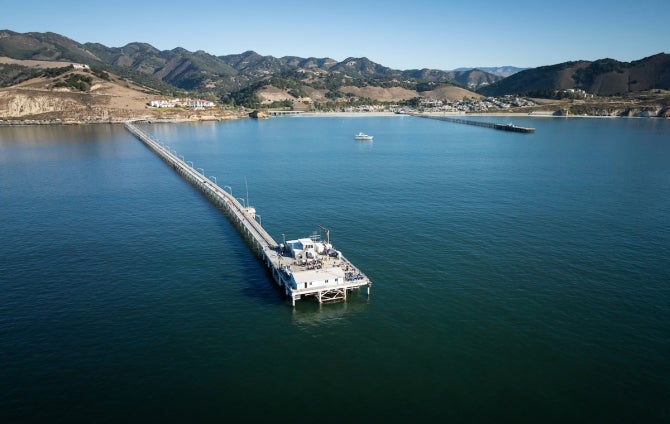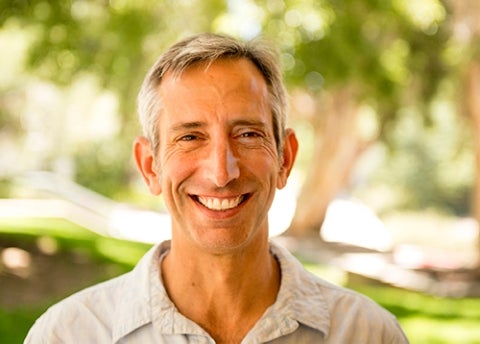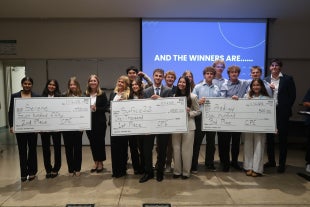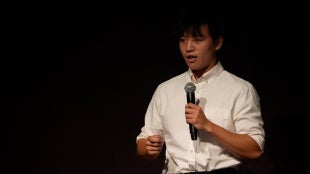Cal Poly Pier Designated for Wave Energy Testing Site by U.S. Department of Energy-Funded Program

Contact: Ben Ruttenberg
805-756-2498; bruttenb@calpoly.edu
Avila Beach research facility is the first open-water research pier in the program
SAN LUIS OBISPO — In a new partnership established to enhance and support effective, innovative wave energy technologies, Cal Poly recently was selected as a federal agency’s first open water research pier.
Research access to the Cal Poly Pier, located about 11 miles south of the university campus, will be available through the Testing Expertise and Access to Marine Energy Research Program, or TEAMER, which is sponsored by the U.S. Department Energy. The pier offers applicants developing wave energy innovations open-water access from its 3,000-foot-long marine research station in San Luis Obispo Bay in Avila Beach.
The TEAMER program, first announced in March of 2019, is designed to set up technology developers and researchers with access to U.S.-based facilities and technical expertise to help encourage the success of wave energy commercialization and leverage a largely untapped resource, the power of the sea.
While much of the nationwide network of nearly 50 facilities provides access to key laboratory or computational resources, as well as some open ocean site access (including by vessel in Washington and a test stand stationed in tidal waters in Massachusetts), the Avila Beach site will provide users with direct access in the form of a drivable pier to the marine environment at a facility with convenient access for ocean research.

“The Cal Poly Pier is set up extremely well to test equipment from an easily accessible, shore-based facility without the expense and complications of chartering vessels,” said Ben Ruttenberg, director of Cal Poly’s Center for Coastal Marine Sciences. “Organizations will be able to design their wave energy or other devices and test them easily. The pier is the perfect launching spot for that important (research and development) work.”
Managed by the nonprofit Pacific Ocean Energy Trust, TEAMER may allocate applicants funding support with the goal of accelerating innovative marine energy technology toward commercialization to help meet society’s needs.
Since its formation TEAMER has offered 15 rounds of requests for technical support, a mechanism for marine renewable energy technology developers and researchers seeking access to TEAMER’s network of facilities and expertise for testing and validation. These requests allow for collaboration between the technology developer and the chosen facility to achieve the recipient's technical objectives. Two additional rounds are scheduled this year, with application deadlines of June 6 and Oct. 3.
The Cal Poly Pier is a secured facility in the harbor with drivable access to deploy and test a range of equipment, including wave energy devices, sensors, autonomous vehicles and more.
Cal Poly is a world-class undergraduate research institution with faculty expertise in a wide range of disciplines. The university will work with approved applicants to coordinate operations and facilitate testing deployment. Cal Poly students and faculty will have opportunities for collaboration, including hands-on experience for students.
As a TEAMER site, the Cal Poly facility is expected to attract collaborators such as companies focusing on early-stage research and development, as well as government organizations such as national labs and the U.S. Navy, with potential long-term benefits of new energy technology for remote areas.
All TEAMER deployments will be conducted in accordance with federal, state and local permitting regulations.
While testing sites and pilot projects have demonstrated capability for commercial wave energy in the U.S., the industry has yet to take off. The Cal Poly Pier site marks an opportunity to learn more about how wave energy technology performs in ocean conditions, contributing to supporting the blue economy with clean energy jobs and a new ocean-related industry.
The World Bank defines the blue economy as the “sustainable use of ocean resources for economic growth, improved livelihoods, and jobs while preserving the health of ocean ecosystem.”
“This exciting announcement marks an opportunity for growth and moving marine energy forward,” said Dean Wendt, dean of Cal Poly’s Bailey College of Science and Mathematics. “Innovative technologies that can provide important, sustainable energy solutions will help provide needed infrastructure long into the future. The university’s marine science infrastructure is proud to play a role in supporting this invaluable research and development.”
For more information, visit marine.calpoly.edu/teamer.
About Teamer
Launched in 2019 by the U.S. Department of Energy’s Water Power Technologies Office, the Testing Expertise and Access for Marine Energy Research program pairs promising marine energy startups with experts at national laboratories, universities and other partners in the TEAMER network. The program is directed by the Pacific Ocean Energy Trust, a nonprofit organization.
About the Cal Poly Pier
Cal Poly is a public university with a commitment to hands-on, Learn by Doing education and one of the premier institutions in the world for undergraduate research, including marine science study. The Cal Poly Pier, extending 3,000 feet, was built in 1984 to facilitate oil transport by Unocal Corp., which donated the facility to the university in 2001. The pier now operates as a marine research station with unrivaled access to the marine environment of the Central Coast.
Top Photo
The Cal Poly Pier, located in Avila Beach, California, is a marine research facility operated by the university, extending 3,000 feet into the Pacific Ocean.
Photo by Dylan Head | Cal Poly


